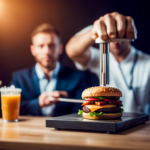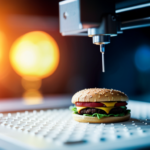In the rapidly evolving landscape of food technology, navigating the intricate web of regulatory requirements for 3D printing businesses is paramount.
As the industry continues to expand, understanding the nuances of compliance standards, safety regulations, and ingredient restrictions becomes increasingly crucial.
This article delves into the comprehensive framework governing food 3D printing, providing essential insights for businesses looking to thrive within this intricate regulatory environment.
Regulatory Agencies and Authorities
The food 3D printing industry must comply with various regulations set forth by federal, state, and local regulatory agencies and authorities. This regulatory oversight ensures that the production and distribution of 3D printed food meet safety and quality standards. Industry collaboration with these regulatory bodies is crucial to establish guidelines that address the unique challenges posed by 3D printed food.
Federal agencies such as the FDA oversee the safety of the food ingredients used in 3D printing, ensuring that they are approved for consumption. State and local authorities also play a role in regulating aspects such as food handling, labeling, and distribution.
Collaboration between the industry and regulatory agencies is essential to foster innovation while ensuring consumer safety. It is imperative for 3D printing businesses to engage with these agencies to stay informed about the evolving regulatory landscape. Proactive participation in industry discussions and compliance with regulatory requirements is fundamental for the responsible growth of the food 3D printing sector.
Compliance Standards and Requirements
Amidst the collaboration between the food 3D printing industry and regulatory agencies, compliance standards and requirements are paramount to ensure the safety and quality of 3D printed food. To meet these standards, businesses must undergo rigorous compliance assessment processes and adhere to industry best practices.
Key components of this include:
-
Regulatory Compliance: Understanding and adhering to the regulatory requirements set forth by governmental agencies to ensure that the 3D printed food products meet all necessary safety and quality standards.
-
Quality Assurance Protocols: Implementing robust quality assurance protocols that encompass every stage of the 3D printing process, from sourcing ingredients to the final product, to guarantee consistent quality and safety.
-
Documentation and Reporting: Maintaining comprehensive documentation and reporting systems to track and trace the production process, allowing for transparency and accountability in case of any quality or safety concerns.
These measures are essential for ensuring that 3D printed food products meet the necessary compliance standards and requirements, ultimately contributing to the overall safety and quality assurance of the industry.
As we delve into the subsequent section about ‘safety and quality assurance’, it becomes evident that compliance standards and requirements form the foundation for upholding the integrity of food 3D printing businesses.
Safety and Quality Assurance
Navigating safety and quality assurance in food 3D printing requires meticulous attention to detail and adherence to industry standards. Conducting thorough risk assessments is essential to identify potential hazards and ensure the safety and quality of 3D printed food products. Implementing robust contamination prevention measures is crucial to mitigate the risk of harmful substances entering the food supply chain.
| Safety Measures | Quality Assurance |
|---|---|
| Conducting risk assessments to identify potential hazards | Implementing strict quality control processes |
| Maintaining hygienic production environments | Regular testing for product consistency |
| Utilizing food-grade materials for printing | Ensuring compliance with food safety regulations |
| Implementing proper storage and handling procedures | Monitoring and documenting production processes |
Ingredient and Material Regulations
Compliance with strict ingredient and material regulations is paramount for food 3D printing businesses to ensure product safety and regulatory adherence.
-
Ingredient sourcing: Food 3D printing businesses must carefully select and source food-grade ingredients that comply with regulatory standards to guarantee the safety and quality of the printed food products.
-
Material testing: Rigorous testing of 3D printing materials is essential to ensure they meet food safety requirements and do not pose any health risks when used in the printing process.
-
Regulatory updates, industry impact: Keeping abreast of regulatory updates is crucial for food 3D printing businesses to adapt their ingredient and material sourcing and testing processes. Industry impact assessments are necessary to understand how regulatory changes affect the business and its operations.
Adhering to these regulations not only ensures the safety of the printed food products but also fosters consumer trust and confidence in the business.
Transitioning into the subsequent section, it is also vital for food 3D printing businesses to be mindful of labeling and packaging guidelines to provide transparent information to consumers.
Labeling and Packaging Guidelines
Transitioning from the considerations of ingredient and material regulations, food 3D printing businesses must now delve into the critical aspect of labeling and packaging guidelines to ensure transparent and informative presentation of their products to consumers.
Labeling and packaging play a crucial role not only in complying with legal requirements but also in establishing brand identity and effective consumer communication.
It is essential for food 3D printing businesses to design labels that provide clear and accurate information about the product, including its ingredients, nutritional value, allergens, and usage instructions.
Additionally, packaging should be designed to ensure the safety and integrity of the printed food products during storage and transportation, while also considering environmental sustainability.
Brand identity should be reflected in the design and messaging of the labeling and packaging to convey the unique selling proposition and values of the business.
Moreover, consumer communication should be prioritized, ensuring that the packaging provides relevant and helpful information to assist consumers in making informed decisions about the 3D printed food products they are purchasing.
Manufacturing Process Oversight
Food 3D printing businesses must ensure rigorous oversight of the manufacturing process to guarantee compliance with regulatory standards and the production of safe, high-quality edible products. This involves implementing robust quality control measures and closely monitoring the production process to uphold the integrity of the final food products.
Key considerations for manufacturing process oversight include:
- Quality Control: Implementing stringent quality control protocols to assess the materials used in the printing process, the printing parameters, and the final printed food products.
- Production Monitoring: Utilizing advanced monitoring and tracking systems to oversee the entire production process, from raw material input to the printing and post-processing stages, ensuring adherence to safety and quality standards.
- Regulatory Compliance: Staying updated with the latest regulatory requirements and ensuring that the manufacturing process aligns with these standards to guarantee the safety and quality of the printed food products.
Efficient manufacturing process oversight is essential for food 3D printing businesses to uphold regulatory compliance and ensure the production of safe, high-quality edible products.
The next section will delve into ‘distribution and supply chain considerations’, addressing the crucial aspects of getting these products to the market while maintaining regulatory compliance.
Distribution and Supply Chain Considerations
Ensuring seamless distribution and efficient supply chain management is crucial for food 3D printing businesses seeking to navigate the regulatory environment and bring their products to market in compliance with industry standards. Supply chain efficiency plays a pivotal role in achieving this goal.
Food 3D printing businesses must carefully consider the distribution logistics involved in transporting their printed food products to consumers. This involves establishing strong relationships with reliable logistics partners who understand the unique requirements of handling 3D printed food items, ensuring proper packaging, transportation, and storage to maintain product integrity and safety throughout the supply chain.
Additionally, maintaining visibility and control over the supply chain is essential for regulatory compliance. Implementing robust tracking and tracing systems can help businesses monitor the movement of their 3D printed food products, enabling quick response in the event of any regulatory issues or product recalls.
Furthermore, businesses must also consider the impact of distribution and supply chain decisions on sustainability and environmental responsibility, aligning with the growing consumer demand for eco-friendly practices.
Future Regulatory Trends and Developments
Anticipating the regulatory landscape for food 3D printing businesses necessitates staying abreast of emerging standards and compliance requirements.
In the future, two key aspects will significantly impact the regulatory environment for food 3D printing businesses:
-
Consumer Acceptance and Market Trends: As the technology evolves, understanding consumer acceptance and market trends becomes crucial for regulatory frameworks. Adapting to changing consumer preferences and market demands will likely influence future regulations to ensure the safety and quality of 3D printed food products.
-
International Implications and Global Standards: With the potential for food 3D printing to transcend national borders, international implications and the need for global standards will become increasingly pertinent. Harmonizing regulations across countries and regions will be essential to facilitate international trade and ensure consistent safety and quality standards for 3D printed food products.
As the industry continues to evolve, these trends will shape the future regulatory landscape for food 3D printing businesses, emphasizing the importance of proactive adaptation to emerging consumer behaviors and global standards.
Frequently Asked Questions
Can Food 3D Printing Businesses Use Recycled or Repurposed Materials in Their Manufacturing Process?
Food 3D printing businesses can use recycled or repurposed materials in their manufacturing process, provided they meet safety and quality standards. This practice can reduce environmental impact and promote sustainability within the industry.
Are There Any Specific Regulations or Requirements for the Use of 3D Printing Technology in the Food Industry?
Regulatory compliance and safety standards are critical in the use of 3D printing technology in the food industry. Ensuring adherence to FDA regulations and industry best practices is essential for consumer safety and the success of food 3D printing businesses.
How Do Food 3D Printing Businesses Navigate Regulations for International Distribution and Supply Chain Considerations?
Navigating international export regulations for food 3D printing involves understanding the complex web of customs, import/export laws, and supply chain management. Businesses must ensure compliance with varying regulations across different countries while maintaining seamless supply chain operations.
Are There Any Limitations or Restrictions on the Types of Ingredients That Can Be Used in 3D Printed Food Products?
When considering the types of ingredients for 3D printed food products, it is crucial to adhere to safety standards and regulations. Limitations or restrictions may apply based on factors such as food safety, allergens, and nutritional value.
What Are the Potential Future Regulatory Trends and Developments That May Impact the Food 3D Printing Industry?
Future innovations and market competition are likely to drive regulatory trends in the food 3D printing industry. Anticipated developments include enhanced safety standards, stricter labeling requirements, and increased oversight to ensure consumer protection and industry growth.
Conclusion
In conclusion, as food 3D printing businesses navigate the regulatory environment, it is crucial to adhere to compliance standards. This includes safety and quality assurance, ingredient and material regulations, labeling and packaging guidelines, manufacturing process oversight, and distribution and supply chain considerations.
Additionally, staying informed about future regulatory trends and developments is essential for long-term success in this evolving industry. It is imperative for businesses to remain vigilant and adaptable in order to meet the demands of an ever-changing regulatory landscape.


